WORLD CLASS COACHING
Tactical Series
Jurgen Klopp
By Alexander Trukan
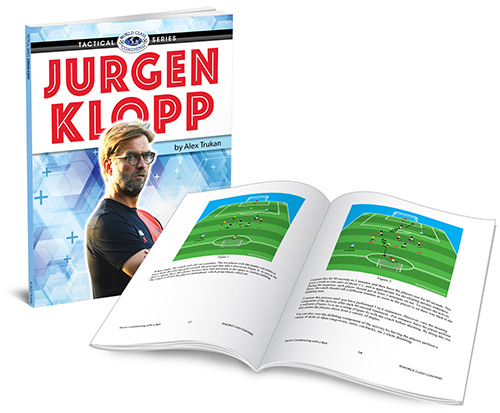
TRANSITION FROM ATTACK TO DEFENSE
This phase has become one of the most recognizable parts of Klopp’s brand of football. ‘Gegenpressing’ (Eng. counterpressing) has been employed by Klopp’s teams both at Dortmund and Liverpool. It is based on acknowledging the fact that opposition upon winning the ball back loses its defensive structure, and is easier to attack. Therefore, if the ball is won back as soon as possible after it’s lost, there will be advantageous opportunities available to penetrate quickly and score.
There are several types of counterpressing - ball oriented, access oriented, leeway oriented and passing lane oriented. Klopp’s teams have a preference for a leeway oriented press which is based on cutting the space out for the player on the ball by blocking passing as well as running lines. The aim of this type of pressing it to win the ball as soon as possible and start the counter – counterattack. The first phase of counterpressing however, happens when the team is still attacking. One of the key components of its effectiveness is remaining in a relatively narrow attacking shape and overloading central areas. This will ensure that players have immediate access to the ball upon losing possession.
As soon as the ball is lost, the role of the nearest player to the ball (not necessarily the one that has lost it) is to press and deny any opportunities to go forwards. At the same time, players around the ball pressurise as well cut off nearest passing lines and spaces to run with the ball. This should be done with high energy and speed. In the initial seconds it is more the role of the reaction and psychological affect rather than tactical structure. The role of the players away from the ball is to get compact and condense the spaces to prevent any long balls through and in behind.
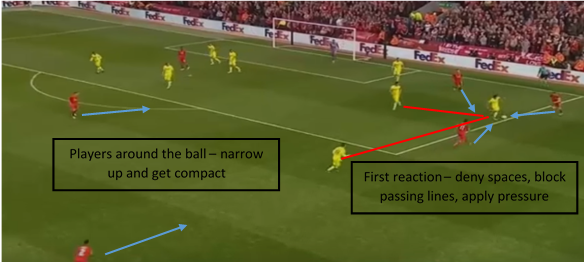
This might often mean that three of four players will be positioned within couple of yards from the ball. The aim here is to either force a pass which can be intercepted or delay the decision (get even narrower) and win the ball back. If that’s not possible, forcing any pass backwards or sideways gives time to reorganise and get compact as a team again. Winning the ball in the final third, provides great opportunities to create chances and overload areas close to the opposition goal.
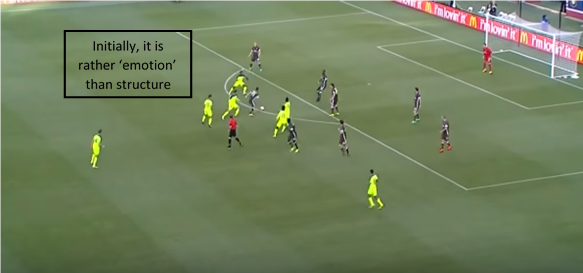
The weakness of this type of strategy, however, are areas away from the ball. Especially at the beginning of Klopp’s work at Liverpool, the team has shown improvement in aggression and reaction to win the ball back but structure and detail were lacking. Despite an increase in ball regained as well as a decrease in ‘no regain’ press, the team was very prone to counter attacks in case the first line of press was broken.
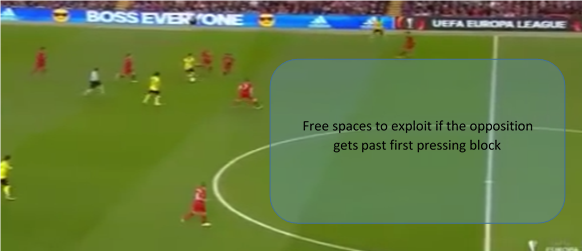
Gaps between units when applying ‘gegenpressing’ might lead to opposition breaking through and opening up spaces for counter. This shows how crucial it is to focus on the compactness of the players away from the ball as well as forcing a player on the ball to look down and therefore stopping any long balls in behind.
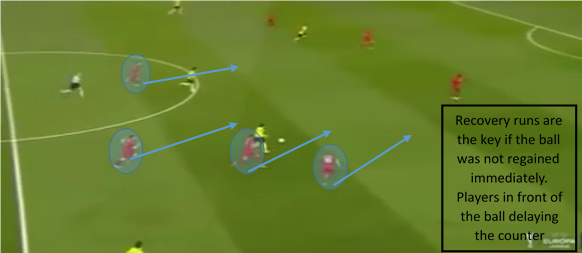
Coaching ‘gegenpressing’ and achieving results with it takes time. Klopp’s achieved initial reaction and aggression improvement after just a week of training, however it took months until the whole structure was improved and synchronised as a whole team. This was then reflected in more balls regained directly from the player on the ball as well as from intercepted passes.
Training practices
Leading in – Possession game 4v4+3
Set up and organization
Organise a pitch of approximately 15 x 25 yards. Divide the group into two teams of four and three neutral players. Two neutral players are positioned on the shorter ends, opposite each other (goalkeepers or centre backs might be used for this role). Third neutral player is positioned in the middle of the area. One of the teams start outside the playing area (attacking) and the other one, inside the area (defending). Prepare a sufficient amount of balls around the pitch to ensure intensity and flow of the practice.
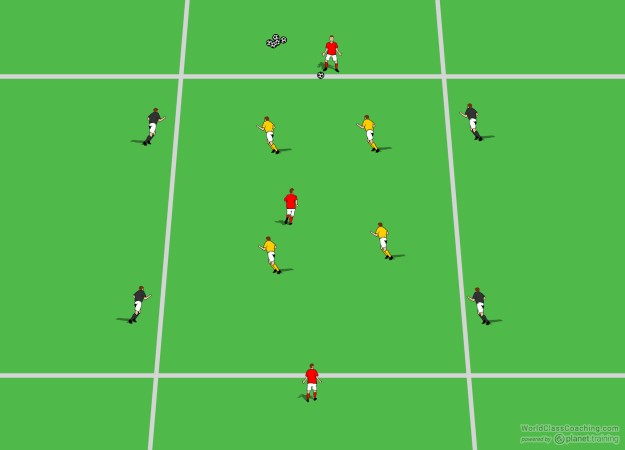
The practice starts from one of the neutral players. The attacking team supported by three neutrals, tries to keep possession of the ball away from the defending team. Certain amount of passes equals a goal (i.e. 10 passes = 1 goal). Defending players try to gain possession as soon as possible.
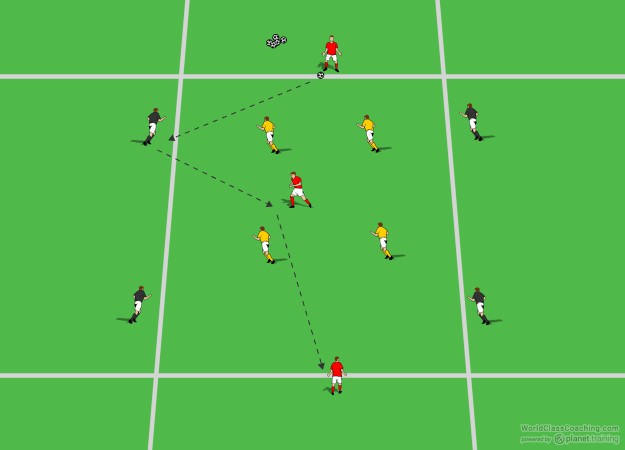
As the defending team gets in possession, they have to take up attacking positions (outside the square). The team that has just lost possession will need to pressurise and try to win possession back before the other team gets organised in attack. Neutral players remain on their positions playing for whichever team is in possession.
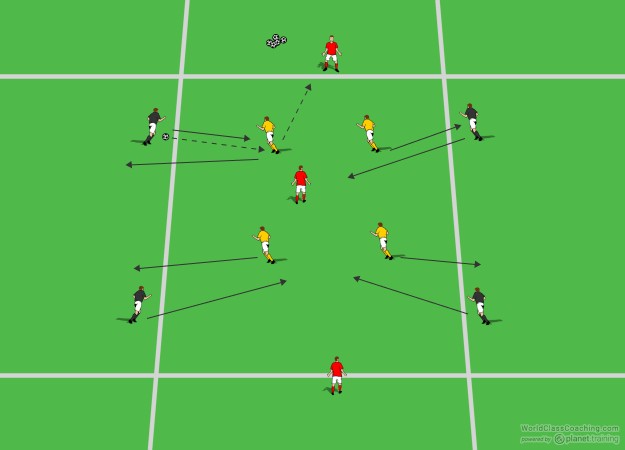
The numbers in this practice might be adapted – 4v4+2, 5v5+3, 6v6+3. Apart from the neutral players on the ends, this practice has not got position specific focus. The main emphasis of this game is to coach initial speed of reaction to losing possession and basic defending principles of ‘gegenpressing’.
Main Part - Small Sided Game 9v9
Set up and organization
Organise a 60 x 40 yards pitch (size may be adapted to suit team needs). Mark out a middle zone, having 15 yards in length. This will divide the pitch into thirds. Split the group into two teams of nine (8+GK). When in positional attack (after 4 seconds from winning possession), first third should be occupied by four players, whereas middle and final thirds, by two. This only applies to a team in possession of the ball. A team that defends in a given moment has a freedom to position their players as they see fit. Prepare a sufficient amount of balls to ensure flow and intensity of the practice.
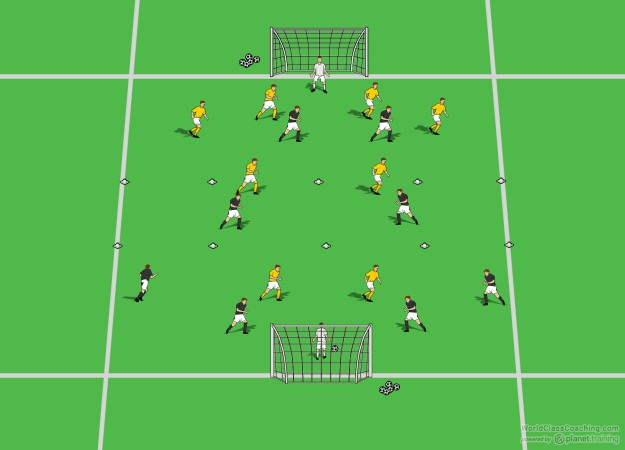
The game starts with a goalkeeper who passes the ball out into of the players from the first third. The attacking team attempts to build up play and score in the opposite goal.
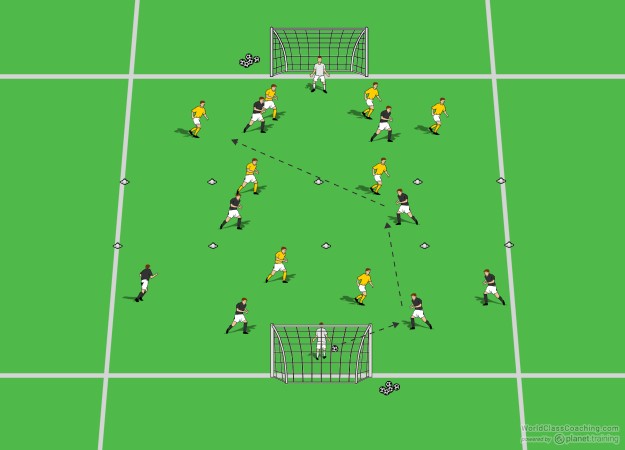
As the team in possession will be underloaded in the final third, a lot of possession turn overs (loses of the ball) will occur in this area. This creates a great opportunity for the team that loses possession to win it back and score straight away (remembering that a team which is defending has a freedom of movement between the thirds). Upon winning possession back, a team has 4 seconds to finalise play until the rule of having only 2 players in the middle and final thirds starts to apply. This condition creates a situation when it can be more advantageous to score from transition to attack, rather than from patient positional attack. It also urges players to be positive and score early after gaining possession.
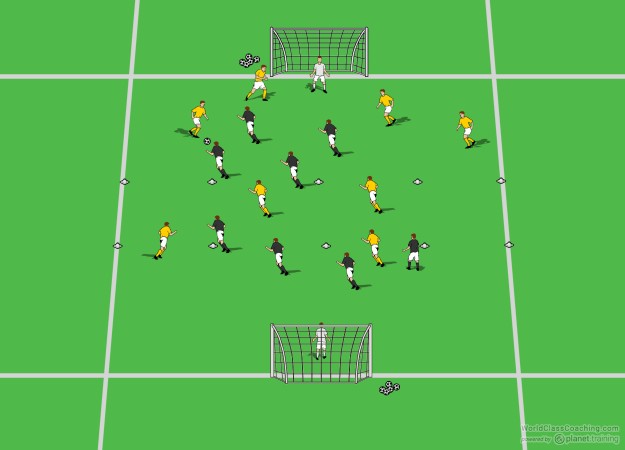
This practice can be further progressed into phase of play with more position specific work in larger areas. Phase of play type of practice will provide more detail and context, however, less constant transitions will occur and the intensity will be lower comparing to small sided game.


